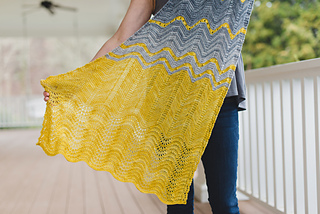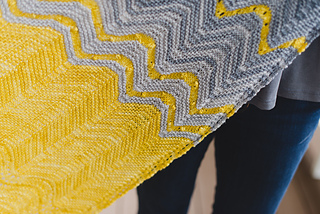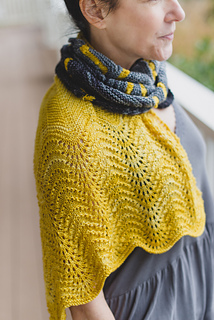patterns >  Wood House Knits and 1 more...
Wood House Knits and 1 more...
> Zora













Zora
While visiting the lovely ladies in the Anzula booth at TNNA I spied this gradient set and of course had to have it because it is all the grey! Zora is a simple straight forward wrap worked in a chevron to highlight the color changes. It has pops of eyelets and bobbles and finishes with an easy lace pattern. Sample is made with Anzula Squishy a lovely light wool blend.
To get a discount on future releases sign up for my newsletter here!
Size:
Finished blocked measurements:
Wingspan: 60”/152.5 cm; depth: 28”/71 cm
Materials:
Yarn: Main Color (MC): Anzula Squishy; 80% Superwash Merino, 10% Cashmere, 10% Nylon; +/- 385 yd / 352 m per 144 g; color: Temperance, 1 skein.
Gradient (G): Anzula Squishy Skeinettes; 80% Superwash Merino, 10% Cashmere, 10% Nylon; +/- 67yd / 61m per 19 g each, +/- 335yd / 306m per 95 g total; color: Citizen Skein, 1 set of 5 mini-skeins.
Needles: Size 3/3.25mm needles, or size to obtain gauge.
Other: Stitch markers (4), tapestry needle.
Gauge: 26 sts and 32 rows = 4”/10 cm in Stockinette Stitch.
Notes:
This wrap is knitted end to end with stitches added along one edge to give a wavy triangular shape. Written instructions are provided for the charts.
Colors are referred to in the pattern as MC and G1, G2, G3, etc. If using a gradient set, determine whether you will work from dark to light or light to dark, depending perhaps on your main color.
You may choose to work the entire project in one color or use color combinations different from the 6-color version shown. To help you calculate required yardages for different options, the sample used 50-60 yds/46-55 m for each of the five gradient colors and approximately 385 yds/352 m of the main color. Though gauge is not usually crucial for this type of project, if you’re using 5 mini-skeins and you’re working at a looser tension, you risk running short.
A video for making bobbles is here. This one is different than the directions in the pattern but gives the same results.
6164 projects
stashed
5596 times
- First published: April 2019
- Page created: April 23, 2019
- Last updated: February 2, 2020 …
- visits in the last 24 hours
- visitors right now




